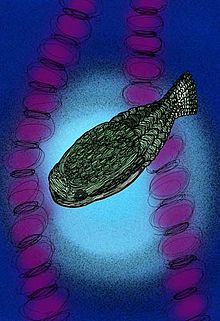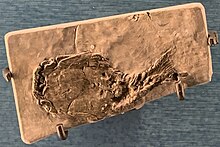
Hans "Dolph" Lundgren is a Swedish-American actor, filmmaker and martial artist. Born in Spånga, Sweden, Lundgren became interested in martial arts at a young age. This would lead him to hold the rank of 4th dan black belt in Kyokushin karate and become European champion in 1980 and 1981. In 1982, while studying to get a master's degree, he became the boyfriend of singer Grace Jones. With her, he moved to New York City and started to take acting classes. In 1985, Lundgren had a breakthrough role playing the lead villain as an imposing Soviet boxer named Ivan Drago in Sylvester Stallone's Rocky IV.
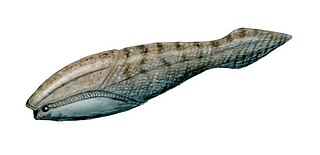
Arandaspida is a taxon of very early, jawless prehistoric fish which lived during the Ordovician period. Arandaspids represent the oldest known craniates, a proposed group of chordates that contain all chordates with a cartilage-derived skull, and hagfish. The group represents a subclass within the class Pteraspidomorphi, and contains only one order, the Arandaspidiformes. The oldest known genus of this group is Sacabambaspis found in South America.

Heterostraci is an extinct subclass of pteraspidomorph, Ostracoderm, jawless vertebrate that lived primarily in marine and estuary environments. Heterostraci existed from the mid-Ordovician to the conclusion of the Devonian.
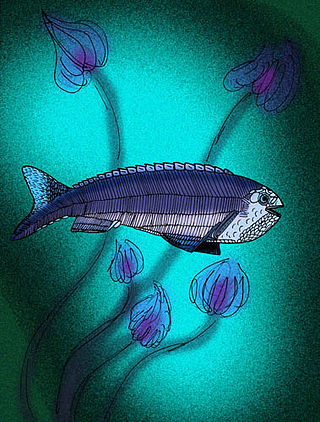
Anaspida is an extinct group of jawless fish that existed from the early Silurian period to the late Devonian period. They were classically regarded as the ancestors of lampreys, but it is denied in recent phylogenetic analysis, although some analysis show these group would be at least related. Anaspids were small marine fish that lacked a heavy bony shield and paired fins, but were distinctively hypocercal.

Galeaspida is an extinct taxon of jawless marine and freshwater fish. The name is derived from galea, the Latin word for helmet, and refers to their massive bone shield on the head. Galeaspida lived in shallow, fresh water and marine environments during the Silurian and Devonian times in what is now Southern China, Tibet and Vietnam. Superficially, their morphology appears more similar to that of Heterostraci than Osteostraci, there being currently no evidence that the galeaspids had paired fins. A galeaspid Tujiaaspis vividus from the Silurian period of China was described in 2022 as having a precursor condition to the form of paired fins seen in Osteostraci and gnathostomes. Earlier than this, Galeaspida were already in fact regarded as being more closely related to Osteostraci, based on the closer similarity of the morphology of the braincase.

Tages were a Swedish rock band formed in Gothenburg in 1963. The group, whose original line-up consisted of Tommy Blom, Göran Lagerberg, Danne Larsson, Anders Töpel and Freddie Skantze, were one of the most successful Swedish bands of the 1960s. They achieved thirteen top-20 singles on Kvällstoppen, such as "Sleep Little Girl", "I Should Be Glad", "In My Dreams", and "Miss Mac Baren", as well as having two albums certified gold, Tages (1965) and Tages 2 (1966).

Parker Lundgren is an American guitarist, best known for being in the progressive metal band Queensrÿche, which he joined in 2009 until 2021.
Sector 236 – Thor's Wrath is a 2010 Swedish horror science fiction film. It was produced by Swedish stuntman Lars Lundgren who also was the main stunt coordinator. Lundgren had previously worked as a stuntman in films such as Planet of the Apes and Thriller - A Cruel Picture.
Capitaspis is an extinct genus of cyathaspidine cyathaspidid heterostracan jawless vertebrate known from the Late Silurian Somerset Island Formation of the Northwest Territories, Canada. It contains a single species, Capitaspis giblingi. It is most closely related to Pionaspis.
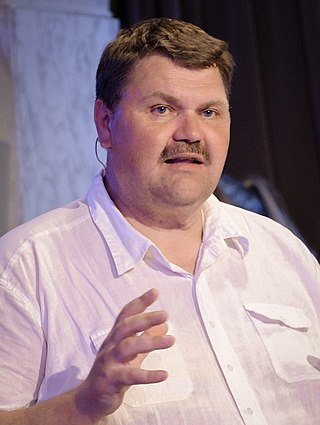
Kent Peter Lundgren is a Swedish politician and Member of the European Parliament (MEP) from Sweden. He was a member of the Sweden Democrats, part of European Conservatives and Reformists.

Panamintaspis snowi is an extinct species of pteraspidid heterostracan agnathan which existed during the early Middle Devonian period of Death Valley, California. Fossils are found in Late Emsian-aged marine strata of the Lost Burro Formation. P. snowi strongly resembles Pteraspis, though while it was originally described as a member of the same family, Pteraspididae, a recent phylogenetic reassessment of the order Pteraspidiformes places P. snowi within the paraphyletic family "Protopeteraspidae," as the sister taxon of the suborder Pteraspidoidei.

Cardipeltis is an extinct genus of heterostracan agnathan from marine strata of early Devonian of Utah, and Wyoming. Species of Cardipeltis superficially resemble those of cyathaspids in having a flattened body and indistinct head covered by a large, broad, guitar pick or heart-shaped dorsal shield, and a long, scaly tail. Unlike cyathaspids, which all have a single ventral plate, however, the ventral shield of Cardipeltis is a mosaic composed of large scales.

Pteraspidiformes is an extinct order of heterostracan agnathan vertebrates known from extensive fossil remains primarily from Early Devonian strata of Europe and North America, and from Upper Silurian Canada.

Cyathaspidiformes is an extinct order of heterostracan vertebrates known from extensive fossil remains primarily from Silurian to Early Devonian strata of Europe, and North America, and from Early Devonian marine strata of Siberia.

Amphiaspidida is a taxon of extinct cyathaspidid heterostracan agnathans whose fossils are restricted to Lower Devonian marine strata of Siberia near the Taimyr Peninsula. Some authorities treat it as a suborder of Cyathaspidiformes, while others treat it as an order in its own right as "Amphiaspidiformes." In life, they are thought to be benthic animals that lived most of their lives mostly buried in the sediment of a series of hypersaline lagoons. Amphiaspids are easily distinguished from other heterostracans in that all of the plates of the cephalothorax armor are fused into a single, muff-like unit, so that the forebody of the living animal would have looked like a potpie or a hot waterbottle with a pair of small, or degenerated eyes sometimes flanked by preorbital openings, a pair of branchial openings for exhaling, and a simple, slit-like, or tube-like mouth.

Cyathaspidida is a taxon of extinct cyathaspidiform heterostracan agnathans whose fossils are found in Silurian to Lower Devonian marine strata of Europe and North America. In life, they are thought to be benthic animals that lived most of their lives either mostly buried in or resting directly on top of the substrate.

Cyathaspididae is an extinct family in the heterostracan order Cyathaspidiformes.

Ctenaspidae is a family of extinct cyathaspidiform heterostracan agnathans in the suborder Cyathaspidida.

Ariaspidae is a family of extinct cyathaspidiform heterostracan agnathans in the suborder Cyathaspidida.

How to Love is a 1947 Swedish drama film directed by Gunnar Skoglund and starring Sture Lagerwall, Wanda Rothgardt and Lauritz Falk. It was shot at the Råsunda Studios in Stockholm. The film's sets were designed by the art director Nils Svenwall.
